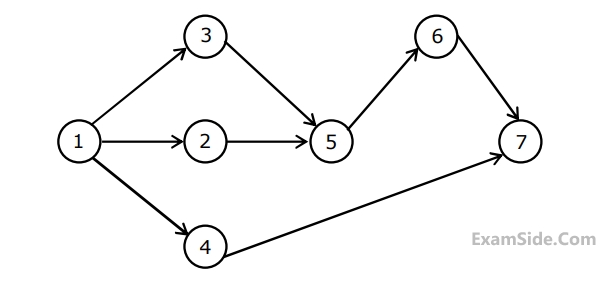1
GATE ME 2009
MCQ (Single Correct Answer)
+1
-0.3
The expected time $$\left( {{t_e}} \right)$$ of a $$PERT$$ activity in terms of optimistic time $$\left( {{t_0}} \right)$$, pessimistic $$\left( {{t_p}} \right)$$ and most likely time $$\left( {{t_L}} \right)$$ is given by
2
GATE ME 2009
MCQ (Single Correct Answer)
+2
-0.6
Consider the following network



The optimistic time, most likely time and pessimistic time of all the activities are given in the table below :

The critical path duration of the network (in days) is
3
GATE ME 2009
MCQ (Single Correct Answer)
+2
-0.6
Consider the following network



The optimistic time, most likely time and pessimistic time of all the activities are given in the table below :

The standard deviation of the critical path is
4
GATE ME 2009
MCQ (Single Correct Answer)
+1
-0.3
Which of the following forecasting methods takes a fraction of forecast error into account for the next period forecast?
Paper analysis
Total Questions
Engineering Mathematics
9
Engineering Mechanics
2
Fluid Mechanics
4
Heat Transfer
5
Industrial Engineering
7
Machine Design
3
Production Engineering
8
Strength of Materials
6
Theory of Machines
6
Thermodynamics
5
More papers of GATE ME
GATE ME 2025
GATE ME 2024
GATE ME 2023
GATE ME 2022 Set 2
GATE ME 2022 Set 1
GATE ME 2020 Set 2
GATE ME 2020 Set 1
GATE ME 2019 Set 1
GATE ME 2019 Set 2
GATE ME 2018 Set 2
GATE ME 2018 Set 1
GATE ME 2017 Set 2
GATE ME 2017 Set 1
GATE ME 2016 Set 1
GATE ME 2016 Set 3
GATE ME 2016 Set 2
GATE ME 2015 Set 2
GATE ME 2015 Set 1
GATE ME 2015 Set 3
GATE ME 2014 Set 1
GATE ME 2014 Set 4
GATE ME 2014 Set 2
GATE ME 2014 Set 3
GATE ME 2014 Set
GATE ME 2014
GATE ME 2013
GATE ME 2012
GATE ME 2011
GATE ME 2010
GATE ME 2009
GATE ME 2008
GATE ME 2007
GATE ME 2006
GATE ME 2005
GATE ME 2004
GATE ME 2003
GATE ME 2002
GATE ME 2001
GATE ME 2000
GATE ME 1999
GATE ME 1998
GATE ME 1997
GATE ME 1996
GATE ME 1995
GATE ME 1994
GATE ME 1993
GATE ME 1992
GATE ME 1991
GATE ME 1990
GATE ME 1989
GATE ME 1988
GATE ME 1987
GATE ME
Papers
2025
2024
2023
2014
2013
2012
2011
2010
2009
2008
2007
2006
2005
2004
2003
2002
2001
2000
1999
1998
1997
1996
1995
1994
1993
1992
1991
1990
1989
1988
1987